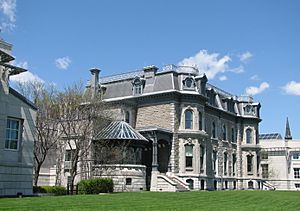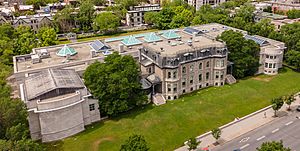Phyllis Lambert facts for kids
Quick facts for kids
Phyllis Lambert
|
|
|---|---|
| Born |
Phyllis Barbara Bronfman
January 24, 1927 Montreal, Quebec, Canada
|
| Spouse(s) |
Jean Lambert
(m. 1949; div. 1954) |
| Parent(s) | Samuel Bronfman (father) Saidye Rosner Bronfman (mother) |
| Relatives | Edgar Bronfman, Sr. (brother) Charles Bronfman (brother) |
| Awards | Order of Canada National Order of Quebec Golden Lion, Venice Biennale of Architecture |
Phyllis Barbara Lambert (born January 24, 1927) is a Canadian architect and a generous person who helps others. She is also a member of the well-known Bronfman family.
Contents
Early Life and Education
Phyllis Lambert was born in Montreal, Quebec. She attended a special school for girls called The Study. Later, she studied at Vassar College and earned her degree in 1948.
From a young age, Phyllis loved art. By age nine, she was already focused on sculpture. People noticed her amazing drawing skills very early in her life. When she was eleven, her art was shown in exhibitions. She became very interested in how art and architecture connect.
Family and Marriage
Phyllis Lambert's family is of Jewish background. In 1949, she married Jean Lambert in Montreal. He was an economic consultant from France and Germany. They divorced in 1954. After her divorce, she stayed in Paris to work on her art and sculpting.
In 1951, her father, Samuel Bronfman, started a company called Cemp Investments. Phyllis was given a 22% share in this company. It managed her family's large business, The Seagram Company Ltd.. This company controlled many businesses, including liquor and real estate.
Her Work in Architecture

While Phyllis Lambert was living in Paris, her father's company, Seagram, planned a new main office in New York City. Phyllis had learned a lot about new art and architecture styles in Paris. She strongly disagreed with the building design her father had chosen.
In a long letter to her father in 1954, Phyllis, who was 27, convinced him to change his mind. She was then given the important job of finding a better architect. After six weeks of searching, she chose Ludwig Mies van der Rohe. He became her mentor and encouraged her dream of becoming an architect.
From 1954 to 1958, Phyllis was deeply involved in designing and building the famous Seagram Building in New York City. She started studying at the Yale School of Architecture in 1958. However, she soon moved to the Illinois Institute of Technology, which she felt was a better fit for her learning goals.
After the Seagram Building
After getting her master's degree in 1963, her family asked her to design an arts center in Montreal. This center was named the Saidye Bronfman Centre, in honor of her mother. Phyllis designed it in a style similar to Mies van der Rohe's work.
Phyllis Lambert continued to work with the Seagram Building until 2000. She was in charge of its upkeep and managed all the art exhibitions and collections there.
Protecting Historic Places

In 1973, a historic building called the Van Horne Mansion was torn down in Montreal. This made many people upset. Phyllis Lambert became a leader in a group called Sauvons Montréal. They worked to save and improve the Shaughnessy Village area.
In 1975, she started a group called Heritage Montreal. This group raised money to help save old buildings. They organized marches, published ads, and worked with local people. They also helped create Canada's largest non-profit housing project, Milton-Parc.
Phyllis Lambert even bought Shaughnessy House herself to save it from being torn down. In 1989, this beautiful 19th-century house became part of the Canadian Centre for Architecture (CCA).
She believed that helping to fix up neighborhoods for people with lower incomes was just as important as saving grand monuments. Since 1997, she has managed a fund called Fonds d’investissement Montréal (FIM). This fund helps bring private money to community housing projects.
Canadian Centre for Architecture
In 1979, Phyllis Lambert founded the Canadian Centre for Architecture (CCA). This is a very important museum and research center in Montreal. She gave 750,000 shares of Seagram to help fund it.
The CCA has a huge collection of architectural drawings, books, photos, and historical documents. The main idea behind the CCA is that "architecture is a public concern." Its goal is to explore how architecture shapes our lives.
Other Projects and Recognition
Phyllis Lambert also worked on other projects. She helped with the design of the Toronto-Dominion Centre in Toronto. She also worked on restoring the Millennium Biltmore Hotel in Los Angeles.
Awards and Honors
Phyllis Lambert has received many awards for her work.
- In 1990, she received an honorary degree in Architecture from the Pratt Institute.
- In 1992, she was honored by France with the Ordre des Arts et des Lettres.
- She has received honorary degrees from about 26 universities in North America and Europe.
She has also received Canada's highest honors:
- She became a Member of the Order of Canada in 1985.
- She was promoted to Officer in 1990.
- She became a Companion of the Order of Canada in 2001.
- In 1985, she was made a Knight of the National Order of Quebec.
- She was promoted to Grand Officer in 2005.
In 2006, she received the Vincent Scully Prize from the National Building Museum. They praised her for her amazing achievements in designing buildings and preserving history.
A documentary film about her, called Citizen Lambert: Joan of architecture, was made in 2007.
In 2014, she received the Golden Lion award at the 14th Venice Architecture Biennale. In 2016, she was awarded the Wolf Prize in Arts.
Phyllis Lambert is one of four important female architects featured in the 2018 documentary film City Dreamers. In 2023, she received the Ada Louise Huxtable prize for her contributions to architecture.
Honours and awards
- Member of the Order of Canada (1985)
- Knight of the National Order of Quebec (1985)
- Officer of the Order of Canada (1990)
- Honorary Doctorate of Fine Arts in Architecture from Pratt Institute (1990)
- Gold Medal from the Royal Architectural Institute of Canada (1991)
- Officer of the Ordre des Arts et des Lettres (1992)
- Hadrian Award of the World Monuments Fund (1997)
- Companion of the Order of Canada (2001)
- Grand Officer of the National Order of Quebec (2005)
- Vincent Scully Prize from the National Building Museum (2006)
- Golden Lion for Lifetime Achievement from the Venice Biennale of Architecture (2014)
- Wolf Prize in Arts (2016)
See also
 In Spanish: Phyllis Lambert para niños
In Spanish: Phyllis Lambert para niños


